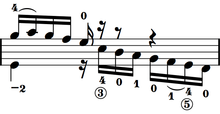Musicality
Musicality (music-al-ity) is "sensitivity to, knowledge of, or talent for music"[1] or "the quality or state of being musical",[1] and is used to refer to specific if vaguely defined qualities in pieces and/or genres of music, such as melodiousness and harmoniousness. These definitions are somewhat hampered by the difficulty of defining music, but, colloquially, "music" is often contrasted with noise and randomness. A person considered musical has the ability to perceive and reproduce differences in aspects of music including pitch, rhythm and harmony (see: ear training). Two types of musicality may be differentiated: to be able to perceive music (musical receptivity) and to be able to reproduce music as well as creating music (musical creativity).[1]
Dance
In dance, musicality is the matching of movement and form to the rhythm, melody, and mood of the music being played.
Dancers may demonstrate musicality in a variety of ways. For example, dancers may synchronize (or syncopate, as in tap dance) movements with music beats, vary the magnitude or speed of movements with music volume, employ expressive movements that are influenced by melody, variations of rhythm, and mood, or combinations of these.
Infant musicality
Colwyn Trevarthen has researched the musicality of babies, including its use in communication.[2][3][4]
Music vs. musicality
Many studies on the cognitive and biological origins of music are centered on the question of what defines music. Can birdsong, the song structure of humpback whales, a Thai elephant orchestra, or the interlocking duets of Gibbons be considered music?[5] This is now generally seen as a pitfall.[6] In trying to answer this question, it is important to separate between the notions of 'music' and 'musicality'. Musicality – in all its complexity – can be defined as a natural, spontaneously developing trait based on and constrained by our biological and cognitive system, and music – in all its variety – as a social and cultural construct based on that very musicality. Or simply put: without musicality no music.[7]
However, it is still a challenge to demarcate precisely what makes up this complex trait we call musicality. What are the cognitive and biological mechanisms that are essential to perceive, make and appreciate music? Only when we have identified these fundamental mechanisms are we in a position to see how these might have evolved. In other words: the study of the evolution of music cognition is dependent on a characterization of the basic mechanisms that make up musicality.[8]
Notes
- Tempo: Slower music gives dancers more time to play, more time for style and variations. Faster music forces dancers to be more creative in their application of style, or possibly use simpler variations depending on the skill of the dancer.
- Follow: Follow may mirror the lead with their arm, feet, and head styling; or they may do the opposite of the lead, or something independent of the lead.
- Footwork: For advanced dancers, footwork is largely independent of body work. Except for needing to move, which foot moves is unimportant. Advanced dancers can do any kind of footwork. The footwork is open to any interpretation.
- Song Structure: Certain types of music have a regular structure, which an experienced dancer can frame his or her moves around. For example, the chorus in some swing music consists of 32 bars, which follows an AABA structure, where each letter consists of four 8-count sections and the B letter has a different melody. The fourth 8-count section of each letter is often an ideal time to execute a break. Other songs have six 8-count sections followed by a chorus of four 8-count sections. "In The Mood" from Glenn Miller is a good example of this type of structure.
See also
- Lead and follow
- Connection
- Dance theory
- Musical composition
- Musical expression
- Musical improvisation
References
- 1 2 3 "Musicality", Merriam-Webster.com.
- ↑ "Why attachment matters in sharing meaning - Colwyn Trevarthen", IRISS.org.
- ↑ Schogler, Ben and Trevarthen, Colwyn. "To Sing and Dance Together", On Being Moved: From Mirror Neurons to Empathy.
- ↑ "Colwyn Trevarthen - Human Nature and Early Experience", Vimeo.com.
- ↑ Wallin, N.J., Merker, B., & Brown, S. (2000). The Origins of Music, . Cambridge, MA: MIT Press. ISBN 9780262731430.
- ↑ Honing, H.; Ploeger, A. (2012). "Cognition and the Evolution of Music: Pitfalls and Prospects". Topics in Cognitive Science. 4 (4): 513. doi:10.1111/j.1756-8765.2012.01210.x.
- ↑ Honing, H. (2012). "Without it no music: Beat induction as a fundamental musical trait". Annals of the New York Academy of Sciences. 1252: 85–91. doi:10.1111/j.1749-6632.2011.06402.x. PMID 22524344.
- ↑ Honing, H.; Ten Cate, C.; Peretz, I.; Trehub, S. E. (2015). "Without it no music: Cognition, biology and evolution of musicality". Philosophical Transactions of the Royal Society B: Biological Sciences. 370 (1664): 20140088. doi:10.1098/rstb.2014.0088.
External links
- AABA: The Map to Swing Music (Rusty Frank)
- Understanding Musicality, academic symposium 2012.
